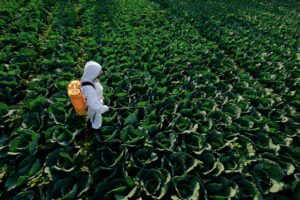With the global population projected to reach nearly 10 billion by 2050, the demand for food, particularly protein, is expected to surge. The traditional sources of protein such as livestock and crops are already under pressure due to land degradation, water scarcity, and climate change. There is a need for an alternative, sustainable source of protein that can meet the growing demand without exacerbating these environmental challenges. Enter algae – a group of photosynthetic organisms that could potentially revolutionize the way we produce protein.
Algae are incredibly diverse, with more than 30,000 known species ranging from microscopic phytoplankton to giant kelp. Many of these species have high protein content, comparable to or even exceeding that of traditional crops and meat. For example, certain species of microalgae such as Spirulina and Chlorella contain up to 70% protein by dry weight, far surpassing soybeans (36%) and beef (26%). Moreover, algae can produce these proteins more efficiently than terrestrial plants and animals. They require less land and water, produce less greenhouse gases, and do not rely on synthetic fertilizers and pesticides.
This high protein content and efficiency make algae an attractive alternative to traditional feed for livestock. Algae can be grown in controlled environments such as photobioreactors or open ponds, allowing for year-round production regardless of weather conditions. They can also be cultivated on non-arable land using saline or brackish water, thus avoiding competition with agriculture for resources. Once harvested, the algae can be processed into a protein-rich feed that can supplement or even replace conventional feedstuffs.
Several studies have shown promising results of feeding algae to livestock. Pigs fed with algae showed improved growth performance and meat quality compared to those fed with conventional feed. Chickens fed with algae laid eggs with higher levels of omega-3 fatty acids. Dairy cows fed with algae produced milk with lower saturated fat content. These benefits not only enhance the nutritional value of animal products but also increase their market appeal.
Beyond providing a sustainable source of protein, algae farming also offers additional environmental benefits. Algae absorb carbon dioxide during photosynthesis, helping mitigate climate change. They can also be used in wastewater treatment, as they can remove nutrients such as nitrogen and phosphorus that cause water pollution. Furthermore, the residual biomass after protein extraction can be converted into bioenergy or bioplastics, contributing to a circular economy.
Despite these advantages, there are still challenges to overcome before algae can become a mainstream source of protein. These include optimizing cultivation methods to maximize yield and consistency, developing efficient harvesting and processing techniques, ensuring product safety and quality, and gaining market acceptance.
Nevertheless, the potential of algae as a sustainable alternative to traditional feed for livestock is undeniable. With continued research and development, it is likely that we will see more farms turning green with algae in the future.

